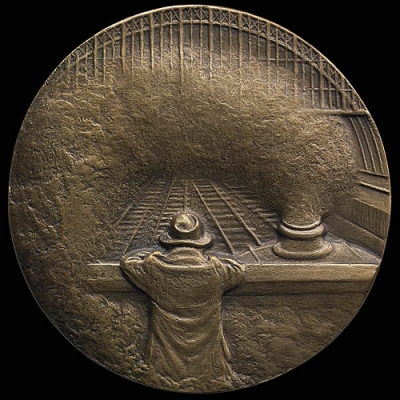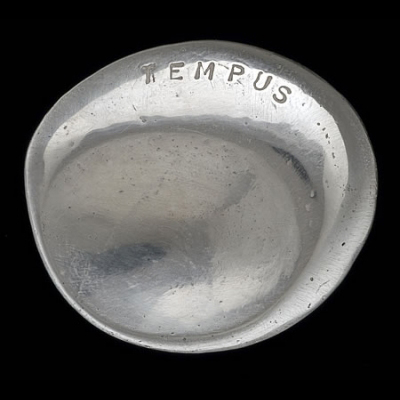Robert Elderton (b. 1948) joined the Royal Mint in 1964 as an apprentice engraver, spending the first year full time at Central School of Art and thereafter one day a week at London’s Sir John Cass School of Arts and Crafts until summer 1971. He remained at the Royal Mint until 2002, where he designed numerous coins and medals. He is an associate of the Royal Society of British Sculptors, a fellow of the Institute of Professional Goldsmiths, and a regular contributor to FIDEM exhibitions. Elderton’s Grace Darling was among the earliest medals issue by BAMS. Nearly thirty years later, his second BAMS medal honours the poet and architectural campaigner John Betjeman. A silver example of this medal exists in the collection of the Goldsmiths’ Company, as reported by the company’s curator Rosemary Ransome Wallis in Goldsmiths’ Review (2009/10), p. 58. BAMS is now pleased to be issuing the medal in bronze. The artist writes: ‘At the age of sixteen, in the summer of 1964, I started work as an apprentice engraver at the Royal Mint, Tower Hill, London. The engraving work practised was die-sinking, which I found quite difficult and challenging. As my five-year training progressed, part of it full-time at the Sir John Cass and part in the Engraving Department of the Royal Mint, an ever-increasing amount of work on the production of coin dies was done by sculpting, with the end product being reduced by machine to form a die. So in fact I did not continue with much die-sinking professionally for the Royal Mint, as I was required to do more via the sculpting method. Since then, I have only picked up my engraving tools about five times. I like to work on a project once in a while to enter into the Goldsmiths’ Craft and Design Council annual competition, to see if my die-sinking skills are still good enough. This is how the Sir John Betjeman obverse came into being and I was lucky enough to win a prize. The Goldsmiths’ Company suggested that if I were to design a reverse and make a complete medal they would love to have a copy for their collection, so I set to work. ‘The refurbishment of St Pancras station was very much in the news when I started the project and, of course, so was Sir John. I was a fan of his since his television programmes of the 1960s: Metroland and so on. Also he was a member of the Royal Mint Advisory Committee during my apprenticeship, so his name always had significance for me. I love his collaboration with Jim Parker, who set some of his poems to music with Sir John voicing them. I play them often while working. The wonderful art nouveau pub, the Black Friar, close to London’s Blackfriars Bridge would no longer be there if not for his help. This alone would be enough reason to celebrate the man. Early sketches for the reverse were of an old steam train and a modern train emerging from St Pancras. Not happy with this, I added Sir John looking into the scene. I looked for an image of him that might suit. A photograph of him was found looking over a wall and it immediately took me back to my early years when the occasional steam train from Fenchurch Street to Southend would run parallel with the District Line tube at Plaistow, where I lived. If we were in the vicinity of one of the road bridges that spanned the tracks, we would jump up and cling to the bridge wall and try to drop anything we could find – empty cigarette packets, ice lolly sticks – into the funnel. I don’t think we ever managed it, but for a small child it was great fun. From seeing that photograph the design changed, and it finished up as you see it now in its modelled form, becoming The Saint of St Pancras. So each side of the medal was produced in a different way – the portrait by die-engraving and the other side modelled.’

The Saint of St. Pancras
The Saint of St. Pancras
By: Robert Elderton, 2009
Medium: cast bronze
Size: 64mm
Cast by: Niagara Falls Castings (UK) Ltd.
Issue: The Medal, no 58 (Spring 2011)
Edition: 36




